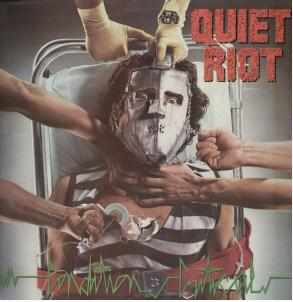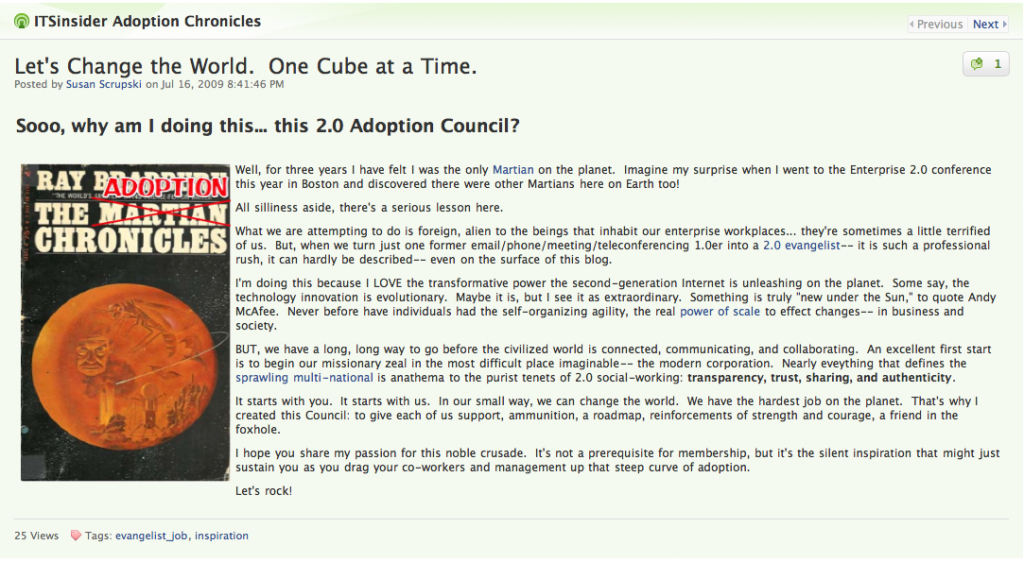 With all my dedicated passion for the social web and its inspirational, world-changing promise, people often wonder why I’ve chosen to focus on the enterprise. My answer is: because it’s hard and #ifnotyouthenwho? One of the last bastions of resistance to embrace the tenets of 2.0 philosophy is found in the large corporate culture. It also happens to be an area where I feel I can do the most good and leverage my career relationships to inspire individuals to start thinking and acting a different (read: better) way.
With all my dedicated passion for the social web and its inspirational, world-changing promise, people often wonder why I’ve chosen to focus on the enterprise. My answer is: because it’s hard and #ifnotyouthenwho? One of the last bastions of resistance to embrace the tenets of 2.0 philosophy is found in the large corporate culture. It also happens to be an area where I feel I can do the most good and leverage my career relationships to inspire individuals to start thinking and acting a different (read: better) way.
That said, the “2.0 for the enterprise” community is small. It is a mere fraction of the worldwide tech population. Consider the Enterprise 2.0 Conference brings out maybe 1500 people. Compare that to, say a tech conference like Oracle OpenWorld, which will draw over 40K people to San Francisco alone next week. Even if you layer on the explosion taking place with social media, social CRM, and online communities, it’s still a relatively new phenomenon even here in the USA where professionals are still just now signing up for LinkedIn and Facebook. The #newTwitter will arrive as the only Twitter for the millions of people who have not been Twitter enthusiasts from the beginning. There will come a time when social media will be like air, but that is still a time in the future.
Considering where we are in the evolution of making a difference, today’s mission should focus squarely on inspiration, not perspiration. It’s that 1% of spark of genius that will ignite a revolution in our time. Last week, I tracked JiveWorld 2010 via Twitter (#JW10). I so now regret not going. My hat is off to Jive for inspiring its customers to go beyond, to literally encourage and support them in their mission to change the world of work. So many of our members who are Jive customers are having career-changing, life-changing experiences as a result of this newfound freedom and empowerment. Take Council member Bart Schutte, for instance, who blogged passionately,
“As someone who has been in the IT industry for 28 years… together we have the opportunity to define this new revolution…I can’t remember being more pumped up about my work. Nothing that I have done over the last three decades will have as big an impact as what I am doing now.”
And it’s not only Jive customers who feel this excitement. Whether our members are working with SharePoint, Lotus Connections, ThoughtFarmer, or the so-called Frankenstein suites that have been integrated to meet the needs of the large enterprise, customers who are in the driver’s seat of this transformation all share a similar desire to create change. My hope is all vendors will inspire their customers to get as charged up as Jive’s customers are. In a small market, it’s easy to get drawn into religious wars over platforms and persuasions, but petty in-fighting is counter-productive to the larger task at hand. That task is expanding the small pie sliver that now comprises the social business movement, so real change can occur on a grand scale.
To the uninspired that are not feelin’ the passion, I feel compelled to address the principle argument against embracing working socially: what’s the ROI? Management theorists have posited that employee engagement leads to business outcomes for years. There are books, lectures, MBA courses that even pre-date the 2.0 enterprise movement that validate this premise. I am not worried there are no formulaic guarantees on social business successes yet. “If you do x, you’ll get y.” Personally, I wish we could change ROI to become Return on Inspiration. The fact remains, large companies who are experimenting and rolling out these massive deployments are still in the early stages. I’m certain the proof positive is coming, but ask yourself: are we measuring the right indicators? Are we (only) looking for evidence under the spotlight of things we know?
Which brings us to the job of the Internal Evangelist. We call them evangelists because they are preaching a foreign gospel in their large organizations. I’ve done this, it’s tough. It’s a thankless and oftentimes painful job. We are researching salaries for internal evangelists in the Council at present. Although I’ve been pleased to see we have fairly high level managers responsible for driving this change, it occurred to me that our members should receive “combat pay” bonuses as part of their compensation package. The career risks our members take every day on the front lines of change, should be rewarded in every way possible. The members come to the Council for refuge, to get support when they are faced with skepticism and setbacks. Yet, we rejoice a lot more than we complain. In fact, we have a running tag in the Council: #clang. We ring a bell for every victory. This tag is by far one of our most popular tags.
Don’t hate the playa; hate the game.
So to all those who wish to derail the conversation away from what is needed right now– passion– I offer this video interview with Seth Godin and dedicate it to the hard-working folks who are doing this every day.
If you don’t have time to watch the whole video, here are some nuggets:
“The heart of what’s going on here; the heart of the shift in our economy is this at the core. You don’t have to be [famous] to do this.”
“It’s not about permission; it’s about the passion and the decision to make an impact.”
“…highlighting and talking about the good stuff and giving those people a platform to succeed.”
“If you’re going to have an impact, you’re going to have to find out where the fear is. What tricks do you have available to you to overturn that resistance to change?”
“Happiness’ best friend is kindness.”
“Passion’s best friend is generosity.”
“Give people the emotional gift of connection and meeting them in ways that matter.”






